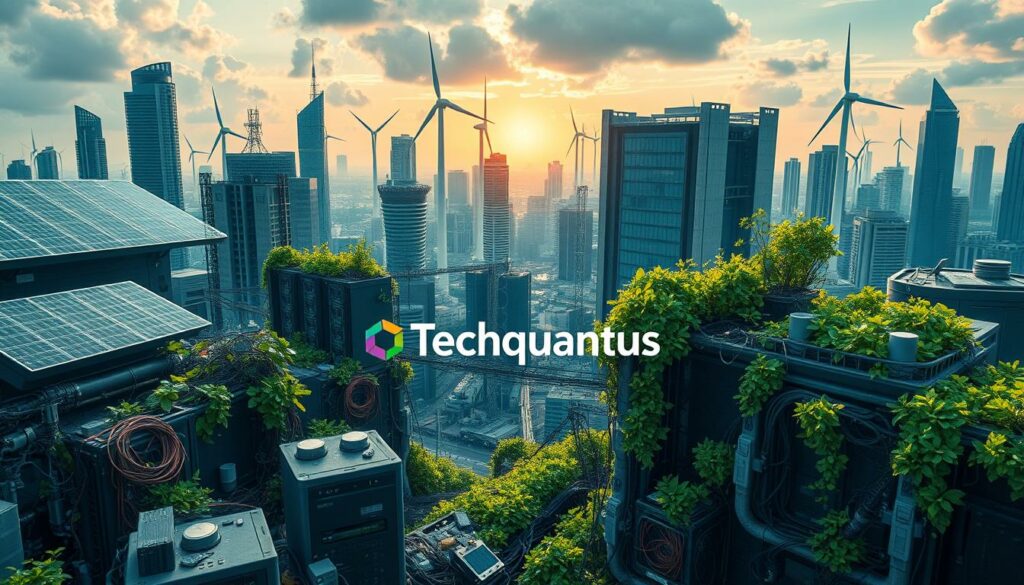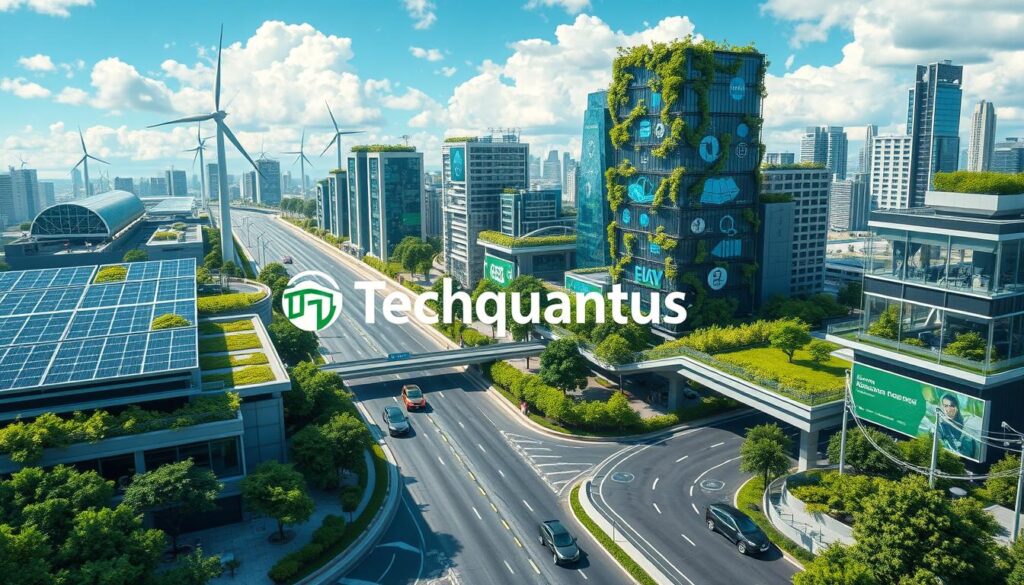Did you know building an eco-friendly house can use just 6kw of energy? For example, WASP 3D printed the ‘TECLA’ house in 200 hours, showing green innovation’s power. Sustainable IT is more than cutting emissions; it’s a big change that brings eco-friendly tech into the industry. It makes businesses more resilient and kinder to the planet.
Companies adopting Sustainable IT help the environment and get better at what they do. Green tech lets businesses grow while cutting down on pollution. This move to Eco-Friendly IT shows a big commitment to being innovative, efficient, and green, changing the industry.
Next, we’ll look at Sustainable IT’s key parts, benefits, and how companies are using it worldwide. For more on how green tech is evolving, check out this link.
Key Takeaways
- Eco-friendly tech is key to lowering carbon footprints.
- Green innovation is pushing new business models in many areas.
- Sustainable IT boosts efficiency and competitiveness in the market.
- Using renewable energy is vital for Sustainable IT success.
- Case studies show eco-friendly practices work well.
- More people want eco-friendly tech now.
- Future trends show a big move towards sustainable tech.
The Rise of Sustainable IT
The rise of Sustainable IT is changing how different sectors work. With growing environmental worries, companies are now pushing for green practices. This change is driven by both laws and what customers want. Over 67% of buyers now choose brands that focus on being eco-friendly.
New tech is key in this change. For example, the Crane WASP 3D printer helps make buildings with less carbon emissions. It successfully printed a 100 m² building, showing the power of 3D printing in green building. The ‘TECLA’ house in 2021 is another example, pushing the limits of sustainable architecture.
Now, tech trends are all about working together for sustainability. TotalEnergies recently put $100 million into sustainable forestry projects. These projects cover 300,000 hectares in the U.S., improving forests and helping with carbon neutrality.
This move towards Sustainable IT isn’t just in building and forestry. The EU is also working on it through the Sustainable Investment Facilitation Agreement (SIFA). This plan helps countries like Angola move away from fossil fuels and towards green energy and digital innovation.
As companies adapt to this new focus on sustainability, we’ll see more customers supporting responsible actions. The rise of Sustainable IT is more than a trend. It’s a big change in how tech and industries work, aiming for the environment.
Understanding Green Technology
Green technology is all about making energy and reducing harm to the environment. It uses renewable resources and aims to make energy use more efficient. This includes everything from how we make things to how we move around.
By choosing eco-friendly ways, companies can cut down on their carbon emissions. This helps them meet global goals for a sustainable future.
The United Nations Development Program (UNDP) is a big supporter of green tech projects around the world. They help use local materials in building projects. This supports the economy and protects the environment.
Companies that go green are not just being kind to the planet. They’re also working on solutions that will last for a long time. Their actions can lessen the harm of climate change and make the planet better for the next generations.
| Aspect | Description |
|---|---|
| Definition | Technologies aimed at reducing environmental impact. |
| Components | Solar energy, wind energy, biofuels, and energy efficiency measures. |
| Benefits | Lower carbon emissions, reduced waste, and promotion of renewable energy. |
| Global Impact | Supports sustainable development goals and international environmental agreements. |
Key Components of Eco-Friendly IT Solutions
Eco-friendly IT solutions have many important parts to lessen environmental harm. A big part is using energy-saving data centers. These centers use less power and cut down on carbon emissions. This is a big step towards using technology in a green way.
Companies that invest in better cooling and power systems see big improvements in efficiency.
Cloud computing is also key in eco-friendly IT. It lets companies use resources that can grow or shrink as needed. This means less need for physical hardware, which leads to less electronic waste. It helps the planet by using fewer fossil fuels and resources than old data centers.
Using materials that can be recycled in hardware production is another big part of green tech. Companies are now looking for parts that can be reused or recycled. This supports a circular economy. By doing this, companies can reduce waste, save money, and build a brand that cares about the environment.
Investing in green IT brings big wins in many areas, like making things run better and following environmental laws. As more people want sustainable choices, companies that use these new techs get ahead. They set the stage for growth and being good for the planet.
Benefits of Sustainable IT Practices
Sustainable IT practices help companies innovate and lessen their environmental impact. They focus on using energy wisely and managing resources responsibly. This leads to big benefits like saving money through lower energy use and fewer costs.
Many big companies are now into remanufacturing as part of their green efforts. For example, IBM and HP are leading the way. Remanufacturing not only makes things more sustainable but also adds value for both the company and its customers. Studies show that remade products can make new ones seem more valuable, showing how being green can boost customer trust.
Reducing the environmental impact is a big plus of sustainable practices. Companies that focus on being eco-friendly cut down on carbon emissions and meet legal standards. This is important because companies that go green often get a better reputation, making customers more interested in what they offer.
In summary, going for Sustainable IT brings many advantages, like big cost cuts and a good name from caring for the planet. As we talk more about being green, it’s clear we need to keep moving towards these practices.
Innovation Driving Sustainable IT
Innovation is key in Sustainable IT, pushing for change and betterment. Companies use green technology advancements to work better and lessen their environmental impact. They’re adopting smart tech, like advanced sensors, to keep an eye on the environment during shipping. This helps them work well and keep an eye on their green goals.
New materials, like Polybutylene Terephthalate (PBT), show the push for eco-innovation. These materials are great because they can be recycled and are light, helping logistics cut down on carbon emissions. This focus on being green not only helps the planet but also makes companies more innovative.
- The rise of smart technologies in logistics enhances monitoring capabilities.
- Eco-friendly materials support sustainability goals and operational efficiency.
- Engaging in challenging projects encourages creativity and innovative thinking.
- Organizations are recognizing the need to adapt to a continuously evolving landscape.
The future of innovation in Sustainable IT is about linking tech with green goals. This approach benefits both businesses and the planet. By adopting these new ideas, companies can improve their image and help protect the environment.
Sustainable IT: Key Strategies and Implementation
Using eco-friendly practices in IT boosts brand value and helps the environment. Strategies for Sustainable IT include using less energy, moving to cloud services, and getting employees involved in green projects.
- Adopt energy-efficient hardware and software systems to minimize power usage.
- Shift to cloud-based models to reduce physical infrastructure and associated emissions.
- Encourage employee involvement in sustainability through training and initiatives.
Companies that follow these strategies can work better, stand out in the market, and build a green culture. It’s key to have leaders who support these efforts throughout the company.
| Strategy | Benefits | Challenges |
|---|---|---|
| Energy-efficient technologies | Reduces operational costs and carbon footprint | High initial investment |
| Cloud-based systems | Increased scalability and lower resource consumption | Data security concerns |
| Employee engagement in sustainability | Boosts morale and productivity | Requires ongoing training and commitment |
Companies can make IT more sustainable by using remanufacturing and understanding how production affects the environment. This means working with the supply chain, solving fairness issues, and seeing the benefits of third-party remanufacturing.

The Role of Renewable Energy in IT
Using renewable energy in IT helps the environment and supports corporate sustainability. Companies can cut their carbon footprint by using solar and wind power.
Switching to green power boosts a company’s social responsibility and cuts down on fossil fuel use. This helps fight climate change by lowering emissions from traditional IT methods.
Going for renewable energy also means saving money on energy costs over time. Companies that invest in green energy are ready for the growing demand for eco-friendly tech. So, adding renewable energy to IT setups is key.
| Renewable Energy Source | Benefits for IT | Impact on Carbon Emissions |
|---|---|---|
| Solar Power | Low operating costs, energy independence | Reduces emissions by up to 90% |
| Wind Power | Scalability, predictable energy output | Reduces emissions by up to 80% |
| Hydroelectric Power | Consistent energy supply, low maintenance | Reduces emissions by about 70% |
Moving to sustainable energy sources sparks innovation in the IT world. As tech gets better, using renewable energy boosts efficiency and supports green business. Companies that use renewable energy improve their green image and help with sustainable development.
Case Studies of Successful Sustainable IT Adoption
Companies are now embracing sustainable IT practices. They show how to use eco-friendly solutions and still be efficient. This is through real-world examples.
Google is a top name in sustainability. It uses renewable energy in its data centers, cutting down on carbon emissions a lot. This shows how tech companies can go green and succeed.
Microsoft is also leading the way with its energy-saving efforts. It has cut greenhouse gas emissions by 60% since 2019. This is thanks to using advanced AI and green energy.
Companies are now turning to 3D printing in construction for sustainability. This tech helps build with less waste and less harm to the environment.
The following table summarizes key examples of successful implementations in sustainable IT:
| Company | Initiative | Outcome |
|---|---|---|
| Renewable energy for data centers | Significant reduction in carbon emissions | |
| Microsoft | Energy-efficient operations | 60% reduction in greenhouse gas emissions |
| Local Builders | 3D printing for eco-friendly buildings | Reduced waste and low-carbon construction |
These examples show how companies can use sustainable IT well. By doing so, they help the environment and work better.
Challenges Facing Sustainable IT Initiatives
The path to Sustainable IT is filled with hurdles. Companies face big costs when starting to use green tech. These costs often stop businesses from fully adopting sustainable practices.
Many people don’t know much about green technology. This lack of knowledge makes it hard for consumers to support sustainable efforts. Companies must work on teaching people about the benefits of Sustainable IT. They should show how it helps the environment and can save money in the long run.
Dealing with complex rules is another big challenge. Companies struggle to keep up with these rules, which slows down their progress. Laws and guidelines change often, making it hard for companies to stay on top of things.
Adding ESG strategies to a company’s plans is tough. They need to make sure their solutions work well in a changing tech world. This means they have to keep up with new trends and what customers want.
- High upfront costs
- Lack of consumer awareness
- Regulatory complexities
- Integration of ESG strategies
- Dynamic technology landscape
To learn more about how to overcome these challenges, think about going to the 2024 Sustainability & ESG Leadership Summit. This event will offer strategies and talks on making sustainable practices work.

Consumer Demand for Eco-Friendly Technology
People are now more aware of environmental issues, changing what they want from technology. They look for products made with the planet in mind. This makes companies work harder to be more sustainable.
Many consumers choose brands that care about the environment. This is true across many industries, like transport and gardening. For instance, the market for transportation batteries is expected to grow a lot, thanks to government support and more people wanting green transport.
The gardening tool market is also seeing a shift towards eco-friendly options. It was worth about $80 billion in 2021 and is expected to hit $110 billion by 2027. Battery-powered tools are popular because they are easy to use and don’t make much noise.
Companies need to pay attention to what environmentally-conscious consumers want. Being sustainable can make a brand look better and help it stand out. As more people want green technology, companies must keep up with these changes.
| Sector | Market Value (2021) | Projected Market Value (2027) | CAGR |
|---|---|---|---|
| Transportation Battery | US$85.67 billion | US$263.78 billion | 13.31% |
| Gardening Equipment | $80 billion | Over $110 billion | 6% |
Choosing sustainable options is key for businesses today. When you pick eco-friendly tech, you’re helping create a better future.
Learn more about sustainability and its impact on business through this resource.
Future Trends in Sustainable IT
Technology is always changing, and Sustainable IT is leading the way to a greener future. Artificial intelligence and machine learning are key in saving energy and making things more efficient. Companies use these tools to create new apps that help the planet.
Renewable energy is becoming more important for powering data centers and offices. This move lowers carbon emissions and saves money over time. Now, businesses see sustainability as a key part of their IT strategy, not just a trend.
Companies need to keep up with new rules and what customers want. With more people worried about climate change, being eco-friendly is key to a good reputation and keeping customers. Using new eco-friendly ideas helps companies meet these needs and build a sustainable culture.
- Enhanced focus on renewable energy integration
- Greater reliance on AI for resource optimization
- Expansion of sustainability-focused policies and regulations
From software that saves energy to hardware made to last and be recycled, Sustainable IT is changing the industry. These trends help you make choices that are good for the planet. By embracing these technologies, your company can lead the green revolution.
Conclusion
Eco-friendly practices are key in the tech world. As companies get judged more on their environmental impact, green tech matters more. Using sustainable IT helps our planet and meets what customers now expect. It’s crucial for companies to switch to sustainable IT to do well in the long run.
By going green, companies can tackle issues like higher costs and new rules. Eco-friendly practices help businesses work better and reduce their harm to the environment. This approach lets companies grow and succeed in a world that wants responsible actions.
Sustainable IT is more than just following rules; it opens up new chances for growth and new ideas. With tech getting better and everyone focusing on being green, making this switch is a must for smart businesses today.
FAQ
What is Sustainable IT?
Sustainable IT means using green tech and eco-friendly methods in the tech world. It aims to lessen environmental harm and save money. It also boosts a company’s social responsibility.
How does Green Technology contribute to sustainability?
Green Technology uses eco-friendly ways like saving energy and using renewable energy. It helps businesses cut down their carbon footprint. This supports sustainable development goals.
What are some key components of Eco-Friendly IT Solutions?
Important parts include energy-saving data centers and cloud computing. Using renewable energy and recyclable materials in hardware is also key. These help lessen environmental harm and save money.
What benefits does Sustainable IT offer businesses?
Sustainable IT brings big cost cuts from energy savings. It also boosts a company’s reputation and meets legal standards. Being eco-friendly makes customers more loyal to a brand.
What role does innovation play in Sustainable IT?
Innovation is crucial for creating new tech that saves energy and cuts waste. For instance, AI and smart tech help use resources better and track environmental effects.
How can companies effectively implement Sustainable IT?
Companies can use cloud systems and energy-saving tech. Getting employees involved in green projects helps too. Strong leadership and planning are key for success.
Why is renewable energy important for IT practices?
Renewable energy like solar and wind power cuts down on IT’s carbon emissions. It supports a company’s social responsibility and reduces fossil fuel use.
Can you provide examples of successful Sustainable IT initiatives?
Many firms have gone green with IT. For example, some use 3D printing for building materials. Others have cut down on energy use with eco-friendly tech.
What challenges do organizations face when adopting Sustainable IT?
Companies face issues like high start-up costs and not enough consumer knowledge. There are also rules and keeping up with new tech and what customers want.
How is consumer demand affecting Sustainable IT?
More people want green tech, pushing companies to go green. They’re changing their products to match what customers want.
What future trends should we expect in Sustainable IT?
We’ll see more focus on new tech like AI for saving energy. Also, expect more eco-friendly solutions as laws get stricter.
Source Links
- UNDP and WASP collaborate on innovative sustainable housing in Colombia – 3D Printing Industry
- Curative waterfalls and ecomedicine in the Austrian Alps
- Watch Sentinel-2C launch live on the final Vega rocket
- TotalEnergies Invests $100M in Sustainable Forestry to Boost Carbon Sequestration – ESG News
- EU-Angola Pact Boosts Sustainable Investment – ESG News
- VIVOTEK Unveils New AI Feature “RealSight Engine” For Unparalleled Visibility
- Transitioning to E-trucks for sustainable transport
- Millets Market Report 2024: Forecast by Product, Application, Distribution Channel, and Country, with Company Analysis 2024-2032 – Rising Demand for Gluten Free and Eco-Friendly Products Driving Market Growth
- Navigating Market Trends – KnowCasino
- Optimal Decisions in an Authorized Remanufacturing Closed-Loop Supply Chain under Dual-Fairness Concerns
- After-Hours Work Challenges and Employee Creativity: A Moderated Mediation Model
- A Study on the Impact of China’s Prefabricated Building Policy on the Carbon Reduction Benefits of China’s Construction Industry Based on a Difference-in-Differences Method
- The critical importance of boron supply in North America
- More sustainable solar modules made from renewable raw materials
- Perceptions of South African Accountants on Factors with a Role in the Adoption of Artificial Intelligence in Financial Reporting
- Sources Analysis and Health Risk Assessment of Heavy Metals in Street Dust from Urban Core of Zhengzhou, China
- Transportation Battery Market Size and Forecast Report 2024-2032
- Gardening Equipment: Tools for a Thriving Green Space
- Digital Cinema Screen Market Size, Share and Forecast By Key Players-Barco , Christie Digital Systems, Doremi Labs, NEC , Qube CinemaÂ
- Global Front Open Shipping Box Market To Attain Valuation of US$ 497.1 Million by 2032 | Astute Analytica
- A. Hatzopoulos S.A. – Sustainable Packaging Solutions for truly Circular Economy
- Color Cosmetics Market to Reach USD 128.7 Billion by 2032 Driven by Increasing Demand for Organic Color Cosmetics |Research by SNS Insider
- Quantum Computing Basics for Beginners: A Simplified Guide
- I Use Prompt Engineering Templates That Work Across ChatGPT, Gemini, Claude & Grok
- I Use Small Business AI Stack: Affordable Tools to Automate Support, Sales, Marketing
- Remote Work Productivity Tips: Maximize Efficiency
- The AI Snitch: Why Grassing Out Colleagues, Even for “Efficiency,” Backfires
Related posts:
 How to Develop Sustainable Technology Solutions for Your Business
How to Develop Sustainable Technology Solutions for Your Business
 How AI is Revolutionizing the E-commerce Industry
How AI is Revolutionizing the E-commerce Industry
 The Role of Quantum Computing in Drug Discovery
The Role of Quantum Computing in Drug Discovery
 How to Ensure Data Privacy Compliance in 2024
How to Ensure Data Privacy Compliance in 2024
 How to Use Digital Twins for Predictive Maintenance in 2024
How to Use Digital Twins for Predictive Maintenance in 2024
 How to Automate Recruitment and Employee Management with AI
How to Automate Recruitment and Employee Management with AI
